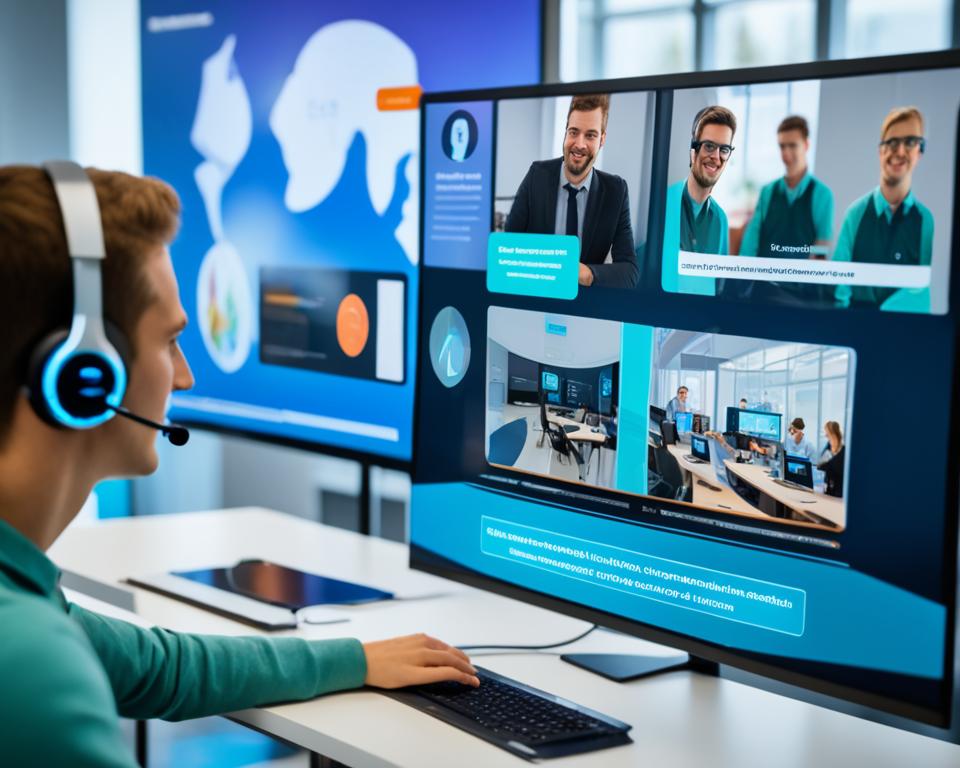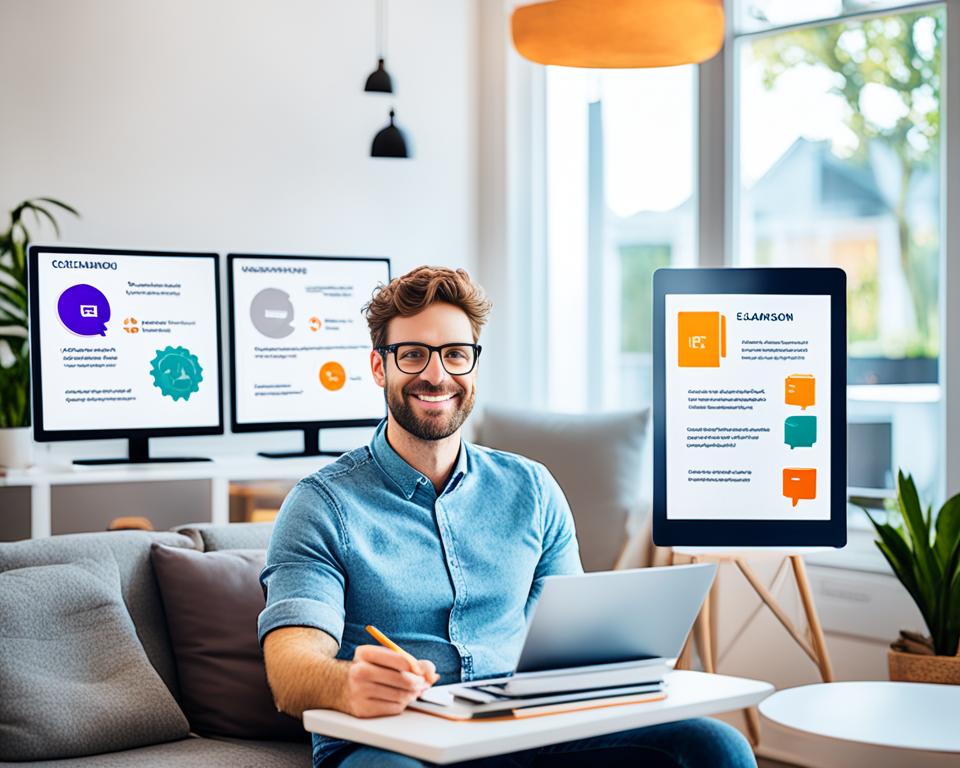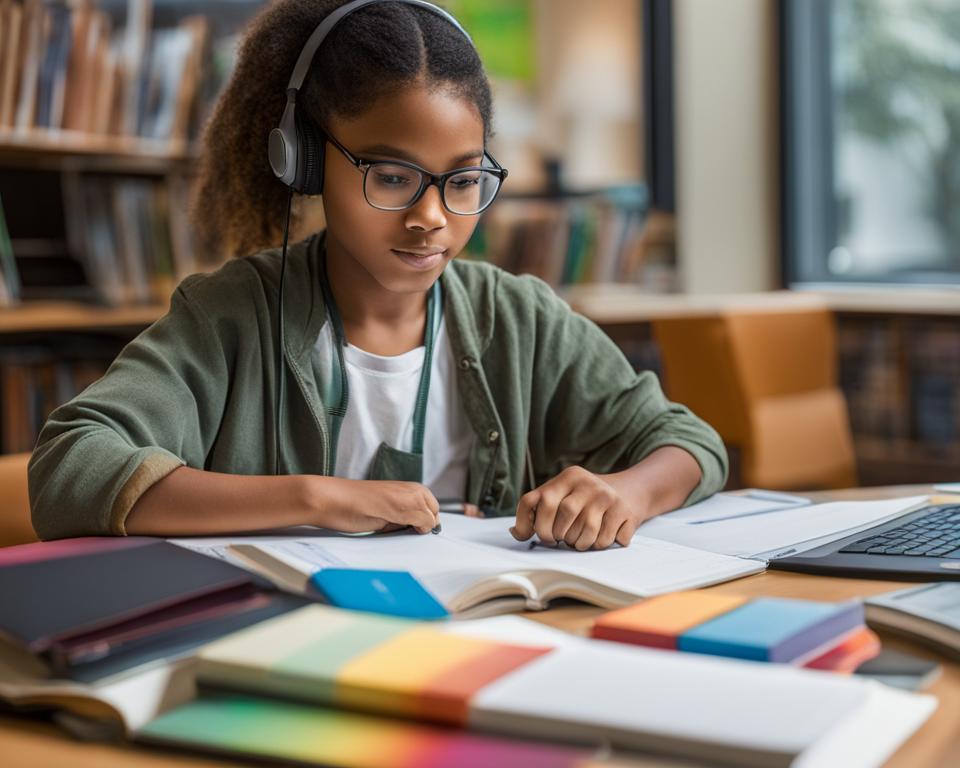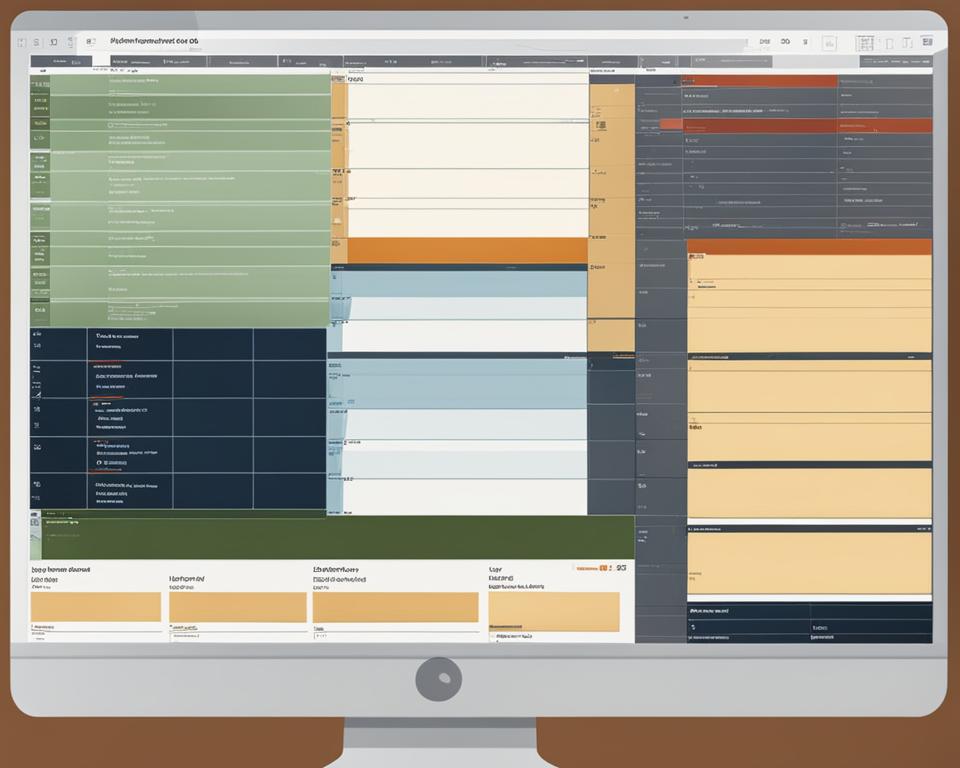Elevate K-12 is revolutionizing education with its virtual classroom program, offering students a transformative experience in online learning and remote education.
Through this innovative program, certified teachers from across the United States are able to deliver live virtual classes, providing students with the opportunity to master essential skills and concepts for future educational success.
By closely monitoring student progress and implementing personalized instruction, Elevate K-12 aims to increase mastery and improve test scores, ensuring that every learner reaches their full potential.
With virtual classroom experiences, students can access education from anywhere, at any time, offering unparalleled flexibility and convenience.
Embrace the future of education with virtual classroom experiences, and elevate your learning to new heights.
Key Takeaways:
- Virtual classroom experiences offer a transformative online learning and remote education environment.
- Elevate K-12’s certified teachers provide live virtual classes to support student mastery.
- Close monitoring of student progress enhances learning outcomes and test scores.
- Virtual classrooms offer flexibility and convenience, enabling education from anywhere, at any time.
- Elevate your learning with virtual classroom experiences and unlock your full potential.
The Benefits of Virtual Classroom Experiences
Virtual classroom experiences offer numerous benefits for students. They provide interactive online classes that engage students in active learning. Through virtual learning platforms, students can participate in dynamic discussions, collaborate with their peers, and communicate with teachers in real time.
Interactive Online Classes
One of the key advantages of virtual classrooms is the ability to deliver interactive online classes. These classes go beyond traditional lectures and textbook learning, as students actively engage with the material through multimedia presentations, interactive exercises, and virtual simulations. By participating in hands-on activities, students can solidify their understanding of concepts and develop critical thinking skills.
Virtual Learning Platforms
Virtual classrooms make use of dedicated virtual learning platforms that provide a rich repository of resources to enhance the learning experience. These platforms offer a wide range of tools and materials, such as educational videos, interactive games, and virtual libraries. Students can access these resources anytime, anywhere, allowing for flexible and personalized learning.
“In virtual classrooms, students can actively participate in discussions, ask questions, and receive immediate feedback from their teachers. This fosters a sense of engagement and motivation, leading to a more effective learning experience.”
Furthermore, virtual learning platforms facilitate collaboration among students. They can collaborate on group projects, share ideas, and learn from one another’s perspectives. This not only promotes teamwork and communication skills but also encourages a sense of community and connection among students, even in a virtual setting.
Additionally, virtual classrooms provide a safe and inclusive learning environment. Students who may feel uncomfortable speaking up in traditional classrooms can express themselves freely through online discussions and chats. This allows for a more equitable and inclusive participation, where all students have a voice and are actively involved in their learning process.
The flexibility of virtual classrooms is another key advantage. Students can access their education from the comfort of their own homes, eliminating barriers such as commuting time and physical distance. This flexibility allows students to tailor their learning schedules to their individual needs, ensuring they can balance their academic pursuits with other commitments, such as extracurricular activities or part-time jobs.
In conclusion, virtual classroom experiences offer a range of benefits for students. Interactive online classes and virtual learning platforms promote active engagement, collaboration, and flexibility in accessing education. By harnessing the power of technology, virtual classrooms create immersive and inclusive learning environments that empower students to thrive and succeed.
The Technology Behind Virtual Classrooms
Virtual classrooms rely on advanced technology to deliver a seamless learning experience. By harnessing virtual classroom software, teachers can conduct live sessions with students, share interactive multimedia content, and foster engagement through video conferencing. This state-of-the-art virtual classroom software empowers educators to create dynamic and interactive learning environments.
One of the key components of virtual classrooms is the availability of virtual classroom tools. These tools enhance the learning experience by providing features such as interactive whiteboards, chat functions, and assessment modules. Interactive whiteboards allow teachers to illustrate concepts visually, encouraging active participation from students. Chat functions enable real-time communication, facilitating collaboration and knowledge sharing among students. Assessment modules provide teachers with the means to evaluate student progress and understanding, ensuring a comprehensive learning experience.
Virtual classroom technology plays a vital role in ensuring student engagement and participation. Through the seamless integration of these technologies, students can actively participate in virtual classrooms, interact with their peers, and engage with the educational content provided by their teachers. This technology creates an immersive and inclusive environment, enabling students to develop skills and knowledge effectively.
Benefits of Virtual Classroom Technology:
- Enhanced accessibility for students, enabling flexible learning opportunities.
- Promotion of interactivity and collaboration through virtual classroom tools.
- Real-time communication and engagement between teachers and students.
- Efficient tracking and assessment of student progress.
- Integration of multimedia content to enrich the learning experience.
Overall, virtual classroom technology enables educators to create dynamic, interactive, and inclusive learning environments. By embracing these innovative tools, educators can deliver a high-quality online education that engages students and fosters their success.
| Virtual Classroom Software | Virtual Classroom Tools | Virtual Classroom Technology |
|---|---|---|
| Enables live sessions and multimedia content sharing | Includes interactive whiteboards, chat functions, assessment modules | Fosters student engagement and active participation |
| Facilitates video conferencing for seamless communication | Encourages collaboration and knowledge sharing | Promotes inclusivity through a comprehensive learning experience |
| Supports efficient monitoring and tracking of student progress | Enhances interactivity and engagement in virtual classrooms | Creates immersive learning environments |
Success Stories of Virtual Classroom Adoption
Many school districts and educational institutions have successfully implemented virtual classrooms, revolutionizing the way students learn. Let’s take a closer look at some inspiring success stories of schools that have embraced virtual classroom experiences to enhance their students’ learning.
Aldine ISD
Aldine Independent School District (ISD) is a prominent example of a district that has implemented virtual classrooms effectively. By integrating virtual learning into their curriculum, Aldine ISD has provided their students with a flexible and engaging education environment. Virtual classrooms have allowed students to collaborate with their peers, participate in interactive activities, and receive personalized instruction.
Grand Rapids Public Schools
Grand Rapids Public Schools has taken virtual classroom adoption to the next level. By leveraging virtual learning platforms, such as Elevate K-12, they have created an immersive online learning experience for their students. The virtual classrooms at Grand Rapids Public Schools offer a wide range of resources and tools that foster creativity, critical thinking, and active learning. Students can access educational materials, engage in discussions, and complete assignments, all within a virtual setting.
Milwaukee Public School District
Milwaukee Public School District has recognized the immense potential of virtual classrooms in expanding access to education. By implementing virtual learning solutions, they have ensured that all students have equal opportunities for learning. Virtual classrooms have allowed Milwaukee Public School District to reach students in remote areas, provide personalized instruction, and support diverse learning styles. The result has been improved student engagement, enhanced academic performance, and increased graduation rates.
These success stories serve as a testament to the transformative power of virtual classrooms. Schools implementing virtual classrooms have witnessed positive outcomes in terms of student engagement, academic performance, and access to education. From elementary schools to high schools, virtual classrooms have proven effective in varied educational settings.
By embracing virtual classroom experiences, schools can unlock a world of possibilities for their students, enabling them to learn in a flexible, interactive, and engaging environment.
Transforming Education with Digital Maturity
In today’s rapidly evolving digital landscape, embracing virtual classroom experiences is a vital component of overall digital change in education. Recognizing this, educational leaders must envision and implement strategies to transform their organizations and ensure they thrive in this dynamic digital world.
To achieve this, educational institutions need to assess their digital maturity and determine where they stand in terms of technology adoption and readiness. This evaluation enables them to identify areas requiring improvement and prioritize initiatives that will propel them towards digital maturity.
An important aspect of this transformation is aligning user journeys with organizational objectives. By understanding the unique needs and goals of learners and the organization itself, educational leaders can curate and tailor digital learning experiences that are both flexible and personalized. This approach fosters a culture of lifelong learning and ensures that educational offerings remain relevant and impactful.
Implementing changes is a multi-faceted process that spans the short, medium, and long term. It involves leveraging digital tools and technologies to enhance and optimize learning experiences, empowering educators to deliver engaging and interactive content. Through innovative approaches such as blended learning, gamification, and augmented reality, students can actively participate in their learning journeys and develop the skills they need for success in the digital age.
Furthermore, integrating digital learning platforms and management systems enables educational institutions to streamline administrative tasks, monitor student progress, and gather valuable data for continuous improvement. These digital tools also facilitate collaboration and communication among students, teachers, and parents, creating a holistic learning environment that extends beyond the physical boundaries of a traditional classroom.
Ultimately, by embracing digital change and striving for digital maturity, educational institutions can provide transformative and impactful learning experiences that prepare students for the opportunities and challenges of the future.
<!–
: Add compelling subheadings
Add an insightful quote related to digital maturity in education.
Continue exploring the various facets of digital transformation in education by diving into the next section, which focuses on designing engaging learning experiences.
| Benefits of embracing digital maturity in education | Challenges and considerations in the digital transformation journey |
|---|---|
| Personalized and flexible learning experiences | Ensuring equitable access to digital resources and technologies |
| Enhanced collaboration and communication | Addressing the digital divide |
| Efficient administrative processes | Building digital literacy among educators and students |
| Improved data-driven decision making | Protecting student data and privacy |
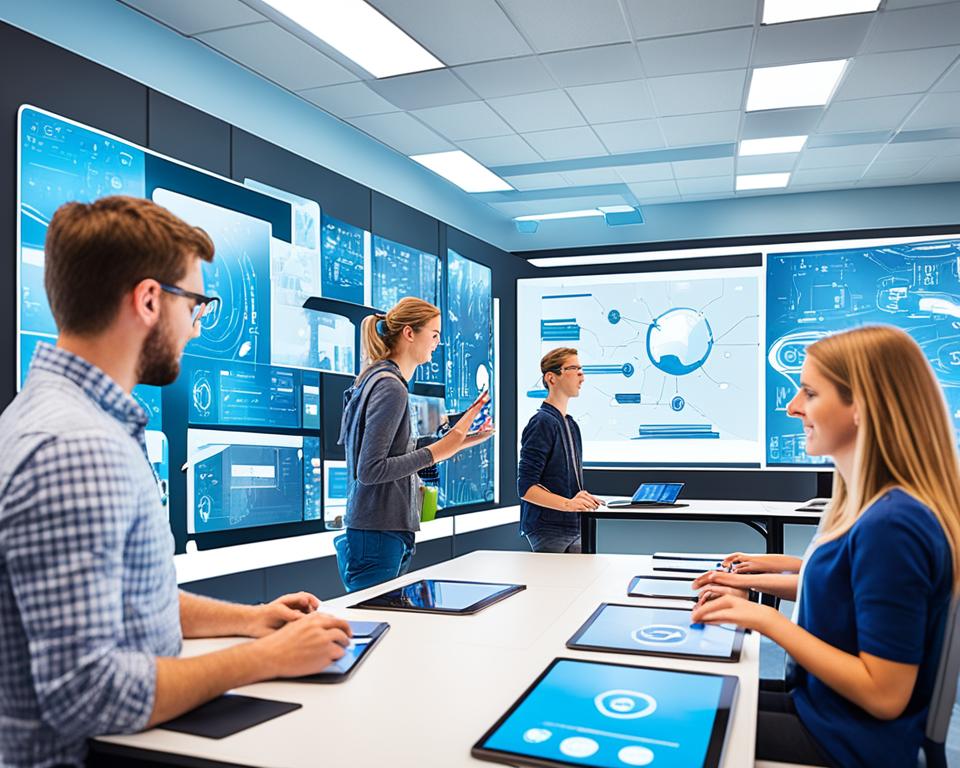
Add a thought-provoking subheading related to digital maturity in education.
Conclude this section with a powerful statement highlighting the overarching importance of digital maturity in education, paving the way for the subsequent sections.
–>
Designing Engaging Learning Experiences
Learning experience design combines the principles of user experience design and adult learning to create engaging and effective learning programs. By understanding learners’ baseline skills, preferred learning styles, and organizational needs, educators can design interactive and user-centered learning experiences that promote goal-oriented learning.
Effective learning experiences are designed with the learner in mind. They align with individual needs and preferences, ensuring that learners stay motivated, engaged, and focused on achieving their goals. By taking a user-centered approach, educators can create programs that cater to different learning styles and maximize the learning potential of each individual.
Creating Interactive and User-Centered Programs
An interactive learning experience encourages active participation and fosters deeper understanding and retention of knowledge. Through the use of interactive elements such as simulations, gamification, and multimedia resources, learners can engage with the content and apply their understanding in real-world scenarios.
A user-centered approach involves considering the needs, expectations, and experiences of learners throughout the design process. By gathering feedback and conducting user research, educators can tailor the learning experience to address specific challenges and provide relevant and personalized content. This approach empowers learners to take ownership of their learning journey and ensures that the learning experience meets their unique needs.
A well-designed learning experience is responsive to the individual needs of learners, promotes goal-oriented learning, and enhances overall performance, productivity, and engagement.
Goal-Oriented Learning for Success
Goal-oriented learning is an essential aspect of learning experience design. By setting clear learning objectives and aligning them with the desired outcomes, educators can guide learners towards success. Breaking down learning goals into manageable steps and providing clear milestones helps learners track their progress and stay motivated.
Furthermore, designing learning experiences that provide opportunities for learners to apply their knowledge and skills in practical, real-world scenarios enhances the relevance and effectiveness of the learning process. This hands-on approach fosters critical thinking, problem-solving, and the development of transferable skills essential for success in various domains.
Improving Performance and Engagement
Engaging learning experiences not only improve the effectiveness of learning but also enhance performance and productivity. When learners are actively engaged and motivated to achieve their goals, they are more likely to invest time and effort into the learning process, resulting in improved outcomes.
By leveraging technology, educators can create dynamic and interactive learning experiences that capture learners’ attention and maintain their engagement. Incorporating elements such as multimedia resources, collaborative activities, and interactive assessments keeps learners actively involved in the learning process and promotes a deeper understanding of the subject matter.
| Benefits of Designing Engaging Learning Experiences |
|---|
| Enhanced learner motivation and engagement |
| Improved knowledge retention and understanding |
| Increased learner satisfaction and enjoyment |
| Development of essential skills for future success |
Designing engaging learning experiences through learning experience design, user-centered learning, and goal-oriented learning is crucial for fostering effective, enjoyable, and impactful learning experiences. By leveraging these principles, educators can create programs that cater to the unique needs of learners, promote active participation, and drive individual performance and engagement.
The Role of Learning Management Systems
In virtual classrooms, learning management systems (LMS) and other digital technologies play a crucial role in facilitating a seamless and effective learning experience. LMS enable educators to efficiently manage online learning, including tracking and monitoring student engagement and performance.
With the help of learning management systems, educators can easily create and deliver interactive course materials, assessments, and assignments. They can also track student progress, offering personalized feedback and support. This allows for a more individualized learning experience, catering to the unique needs and pace of each learner.
Additionally, learning management systems provide social learning tools that promote collaboration and knowledge sharing among students. These tools enable learners to engage in group discussions, participate in virtual projects, and share resources, fostering a sense of community within the virtual classroom.
An integrated learner management system provides a holistic learning journey for students, from the acquisition of new knowledge and skills to their application and adoption. These systems enable educators to design learning paths that align with learning objectives and competencies, ensuring a cohesive and comprehensive learning experience.
Moreover, learning management systems offer valuable data and analytics capabilities, allowing educators to measure the return on investment of virtual classroom experiences. By analyzing student performance and engagement data, educators can identify areas for improvement and make data-driven decisions to enhance the learning experience.
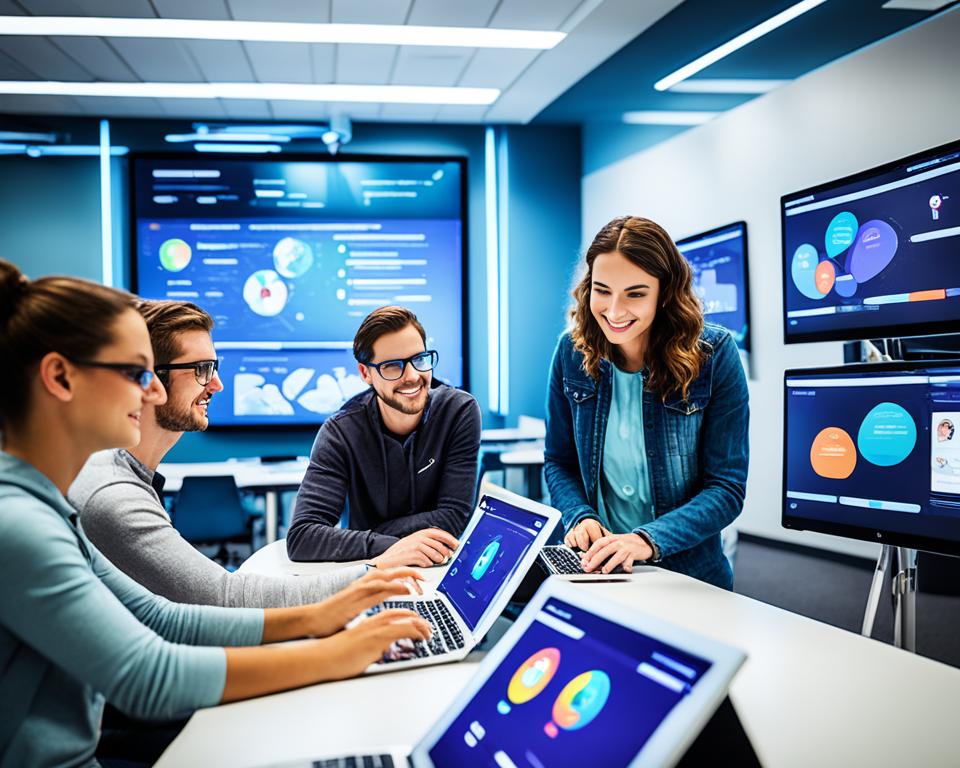
The Future of Virtual Classroom Experiences
In the ever-evolving landscape of education, virtual classrooms have emerged as a powerful tool for delivering remote instruction. As technology continues to advance, the future of virtual classroom experiences holds great promise, ushering in a new era of virtual learning.
One of the key advancements we can expect in virtual classrooms is the integration of augmented reality (AR) and virtual reality (VR) technologies. By incorporating AR and VR elements into virtual classrooms, students will have the opportunity to immerse themselves in rich and interactive learning environments. They can explore historical sites, engage in hands-on experiments, and interact with virtual objects, enhancing their understanding of complex concepts.
Artificial intelligence (AI) and data analytics will also play a vital role in the future of virtual learning. These technologies have the potential to transform instruction by providing personalized learning experiences tailored to each student’s individual needs. AI algorithms can analyze a student’s learning style, progress, and performance data to generate adaptive instruction and targeted interventions. This personalized approach ensures that every student receives the support and guidance necessary to achieve their full potential.
Furthermore, the future of virtual classrooms will feature advanced collaboration tools, fostering seamless communication and interaction among students and teachers. Real-time collaboration platforms will enable students to collaborate on projects, participate in group discussions, and receive immediate feedback from their peers and instructors. These interactive experiences promote engagement, critical thinking, and socialization, mirroring the dynamics of traditional classrooms.
As we look ahead, we can anticipate a future where virtual classrooms become even more immersive, interactive, and adaptive. Students will have access to cutting-edge technologies that enhance their learning experiences and bridge the gap between the physical and virtual worlds. With advancements in AR, VR, AI, and collaboration tools, virtual classroom experiences will continue to pave the way for a transformative educational landscape.
Parental Involvement in Virtual Classroom Experiences
To ensure the success of students’ virtual learning experiences, parental involvement plays a critical role. By actively engaging in their child’s virtual education, parents can provide essential support and assistance. Here are some ways parents can support and contribute to their child’s virtual learning journey:
1. Encourage Regular Attendance
Parents can help their child by ensuring they attend virtual classes regularly. By establishing a consistent routine and emphasizing the importance of attendance, parents can instill good habits and discipline in their child’s virtual learning experience.
2. Ask About What They Learned
Engaging in meaningful conversations about what their child learned during virtual classes allows parents to assess their progress and understanding. By showing genuine interest, parents can encourage their child to actively participate and reflect on their virtual learning experiences.
3. Familiarize Themselves with Virtual Classroom Resources
Virtual classroom platforms often provide resources specifically designed for parents. These resources can help parents better understand the curriculum, teaching methods, and expectations of the virtual classroom. By familiarizing themselves with these resources, parents can effectively support their child’s learning and address any challenges they may encounter.
4. Communication with Teachers
Establishing open lines of communication with teachers is crucial for parents to stay informed about their child’s progress and any obstacles they may face. By actively engaging in dialogue with teachers, parents can collaborate with them to ensure their child’s virtual learning experience is personalized and effective.
By implementing these strategies, parents can actively contribute to their child’s virtual education and provide the necessary support for success. With parental involvement, students can thrive in virtual classrooms, maximizing their learning potential and achieving their academic goals.
Conclusion
Virtual classroom experiences have revolutionized online learning and remote education, transforming the way students engage with their education. With the use of advanced technology, virtual classrooms offer a dynamic and interactive learning environment that brings numerous benefits to students.
One of the key advantages of virtual classrooms is the ability to participate in interactive classes. Students can actively engage with the content, ask questions, and collaborate with their peers, promoting a deeper understanding of the subject matter. This level of engagement leads to increased student motivation and improved academic performance.
In addition, virtual classrooms foster enhanced collaboration between students and teachers. Through the use of virtual learning platforms, students can communicate and share ideas with their classmates and educators. This collaboration encourages the development of critical thinking and problem-solving skills, as well as the ability to work effectively in a team.
Moreover, virtual classrooms provide flexibility in accessing education. Students can attend classes from the comfort of their own homes or any location with an internet connection. This accessibility eliminates geographical barriers and allows for personalized learning experiences that fit each student’s individual needs and schedules.
As education continues to evolve digitally, virtual classrooms are poised to play an increasingly important role in shaping the future of learning. The success stories of schools that have implemented virtual classrooms demonstrate the significant impact on student engagement and academic performance. The transformative nature of virtual classrooms, combined with advanced technology, promises an exciting future in virtual education.
FAQ
What is Elevate K-12?
Elevate K-12 is a virtual classroom program that allows certified teachers from across the United States to instruct students in live virtual classrooms. It aims to support students in mastering essential skills and concepts for future educational success.
What are the benefits of virtual classroom experiences?
Virtual classroom experiences offer numerous benefits, including interactive online classes, enhanced collaboration among students and teachers, and the flexibility to access education from anywhere, at any time.
What technology is used in virtual classrooms?
Virtual classrooms rely on advanced technology such as virtual classroom software, interactive whiteboards, chat functions, and assessment modules to deliver a seamless learning experience.
Can you provide examples of successful virtual classroom implementation?
Yes, several school districts and educational institutions, including Aldine ISD, Grand Rapids Public Schools, and Milwaukee Public School District, have successfully embraced virtual classroom experiences to enhance their students’ learning.
How can educational leaders embrace digital change in education?
Educational leaders can embrace digital change by assessing their digital maturity, aligning user journeys with organizational objectives, and implementing changes in the short, medium, and long term to create a culture of lifelong learning.
What is learning experience design?
Learning experience design combines user experience design and adult learning principles to create engaging and effective learning experiences that respond to learners’ needs and improve individual performance, productivity, and engagement.
What is the role of learning management systems (LMS) in virtual classrooms?
Learning management systems play a crucial role in virtual classrooms by seamlessly managing online learning, tracking engagement and performance, and facilitating collaboration and knowledge sharing among learners.
What does the future hold for virtual classroom experiences?
The future of virtual classroom experiences holds great potential for advancements in virtual learning, including the integration of augmented reality and virtual reality for an immersive learning experience, as well as innovations in artificial intelligence and data analytics for personalized and adaptive instruction.
How can parents be involved in supporting virtual learning?
Parents can support virtual learning by ensuring their child attends virtual classes regularly, asking about what they learned, and familiarizing themselves with the resources available for virtual learning. Active parental engagement contributes to student success and progress.
What is the conclusion regarding virtual classroom experiences?
Virtual classroom experiences have transformed online learning and remote education, providing dynamic and engaging environments for students. They offer numerous benefits, and their successful implementation in various educational settings highlights their positive impact on student engagement and academic performance.

